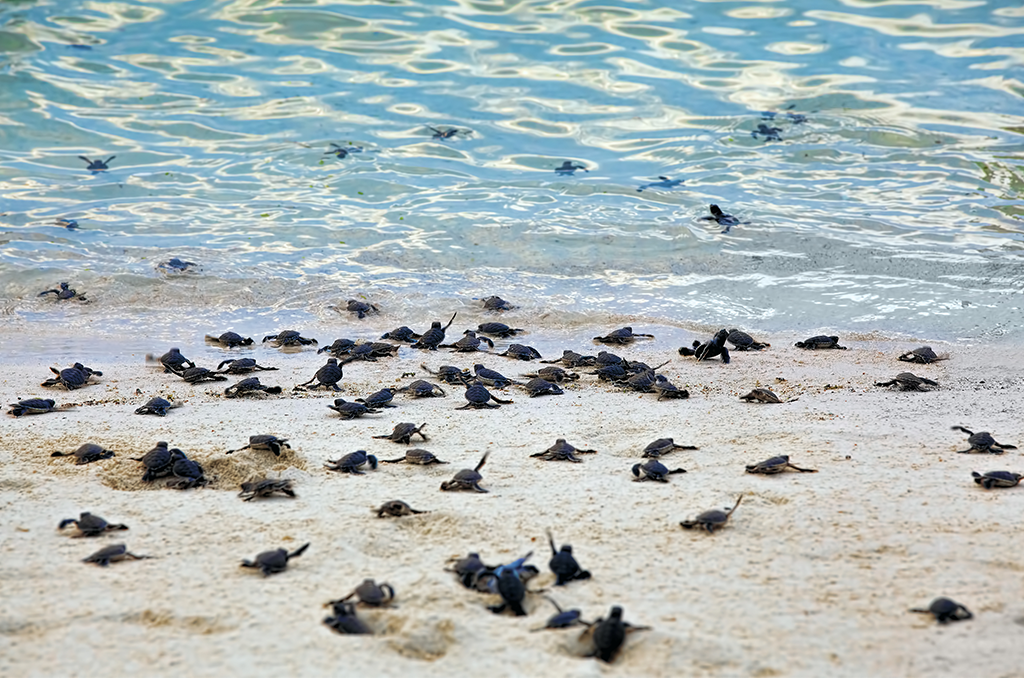Sea Turtle Hatchlings – Courtesy: Shutterstock – Image by Kjersti Joergensen
CLEARWATER, Fla. — Every sea turtle season, state wildlife officials make it a priority to remind beachgoers of the importance of keeping baby turtle hatchlings safe as they make their way to the ocean on their own.
Throughout the weekend, Florida Fish and Wildlife Conservation Commission issued several reminders and warnings, stating that baby sea turtles are hatching along Florida’s beaches. Sea turtle season usually falls between March 1st and October 31st.
“It is important to keep your distance from sea turtles and their nests on the beach,” according to an FWC statement. “Sea turtles are protected, so you should allow hatchlings to crawl toward the ocean on their own. Any interference or disturbance, including getting too close, can cause hatchlings to become confused and lose their way.”
Officials warned that bright lights emitted from cell phones, cameras, or local buildings can cause disorientation among the baby turtles, causing them to stray away from their destination.
According to FWC, “if they are unable to reach the ocean quickly, they can become dehydrated and exhausted, making them an easy meal for predators.”
All five sea turtle species in Florida are either threatened or endangered, meaning it is strictly illegal to harass, harm, or kill any sea turtles, their eggs, or hatchlings.
The Endangered Species Act lists the hawksbill, leatherback, green, and Kemp’s ridley turtle as endangered. The loggerhead turtle falls under the threatened species list.
“Interfering with a sea turtle hatchling’s trek to the ocean can have fatal consequences,” FWC sea turtle biologist Dr. Robbin Trindell said in a statement. “It’s very important to leave them undisturbed. By keeping beaches dark, beachfront buildings dark, and giving sea turtles space, we can make sure that our children and grandchildren can also enjoy watching them make this amazing journey.”
FWC offered the following advice to keep Florida’s sea turtles safe:
- Keep beaches dark. After sundown, turn off any lights not necessary for human safety. Use long wavelength amber LED lamps for lights that must stay lit and shield lights, so they are not visible from the beach. Remember to close shades or curtains at night.
- No flash photos. On the beach at night, don’t take flash photos or use bright cellphones or flashlights. This can cause turtles to become disoriented and crawl away from the ocean, putting them at risk.
- Remember, sea turtles are protected by law. Keep your distance and give sea turtles space if you see one on the beach. Never touch a nesting turtle because it might leave the beach without nesting if disturbed.
- Clear the way at the end of the day. Beach furniture, boats, toys, and trash left behind on the sand can become obstacles that block crawling sea turtles. Fill in any holes dug in the sand. Holes can trap turtles and they also pose a safety risk to humans.
To learn more about sea turtles in Florida, visit the FWC website.
Are you interested in Florida’s nature? For stories like this and much more: Florida Insider is dedicated to educating, entertaining and informing its readers about everything Florida. Easy to read content at the palm of your hands and covering the stories that matter.
Melissa’s career in writing started more than 20 years ago. Today, she lives in South Florida with her husband and two boys.

